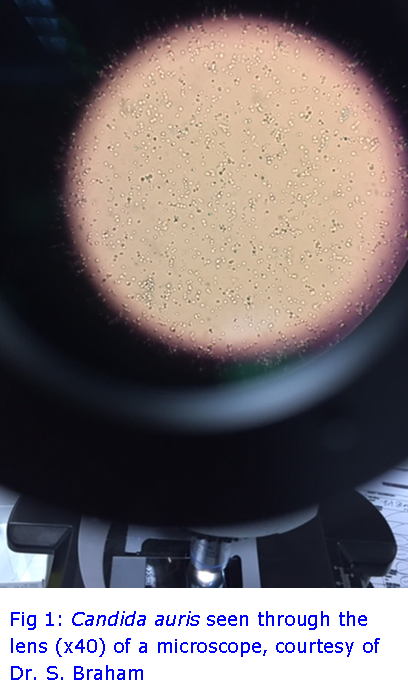Candida Auris: A Newly Discovered, Multi-drug Resistant Pathogen
Why does Candida auris pose a threat?
Candida auris (C. auris) is an emerging multi-drug resistant fungal pathogen first isolated in Japan in 20091 but retrospective studies show it dates back to 1962 in South Korea. Since then, C. auris has caused outbreaks worldwide for instance in India, Brazil, Korea and some countries in South America. It was first described in Europe in October 2016, when it was discovered in a London Cardiothoracic Hospital. Gene sequencing shows that there are differences in the DNA fingerprint of the fungus from different continents.
Although “auris” translates as “ear”, the fungus can also cause colonisation of other areas for example the skin, nose, urinary catheters, vascular access lines and wounds. Infection of wounds and vascular access lines increase the risk of bloodstream infection, which are common. There is a high mortality rate of 50-60%, associated with the fungal pathogen.
C. auris has a very high outbreak potential and appears to be difficult to eradicate from the environment. Hence, a strict level of infection control precautions are required including isolation of infected patients. Screening of contacts is advised to detect early colonisation.
Candida auris causes outbreaks in hospitals, especially in high risk populations where the immune system is weakened, like patients in intensive care or undergoing renal and neurosurgery.
Guidance for managing patients can be found on the Public Health England’s website.
Under the microscope, Candida auris is indistinguishable from most other Candida species and currently available diagnostic panels are unable to identify C. auris, instead they misidentify the organism as for example, Candida haemulonii, Saccharomyces cerevisiae or Candida famata3. Typing methods are also unable to differentiate strains at a local level. These errors can lead to a delay in recognising the infection or an outbreak, which has an healthcare outcome and cost implications. Special diagnostic methods are needed to overcome the limitations of the existing methods.
How can the spread of infection be prevented?
Prevention of hospital infections is a priority for hospitals, but this has resource implications for overstretched NHS Trusts. To prevent the spread of C. auris, we need to screen patients who are in close proximity to infected patients, use special isolation rooms and expensive disposable equipment. Viapath’s plan is to support the existing stringent measures for infection control with the development of a rapid and accurate method of detection of C. auris for use in screening. This aims to reduce the number of patients requiring isolation and help target resources towards true infections and elsewhere where they are needed. Reducing the spread of infection and potentially the length of patient stay in hospital is projected to have a financial benefit as well4.
For further information on the scientific or clinical aspects of Candida auris please contact:
Dr Sharleen Braham: SBraham [at] nhs.net
Dr Surabhi Taori: Surabhi.Taori [at] nhs.net
Or for information on the testing procedures for Candida auris, please contact:
Fearghal Tucker: fearghal.tucker [at] nhs.net
References
1. Satoh, K et al. 2009 Candida auris sp. nov., a novel ascomycetous yeast isolated from the external ear canal of an inpatient in a Japanese hospital. Microbiol Immunol. 53(1):41-4.
2. Lee WG et al. 2011 First three reported cases of nosocomial fungemia caused by Candida auris. J Clin Microbiol. 49(9):3139-42.
3. Kathuria, S et al 2015 Multidrug-Resistant Candida auris Misidentified as Candida haemulonii: Characterization by Matrix-Assisted Laser Desorption Ionization-Time of Flight Mass Spectrometry and DNA Sequencing and Its Antifungal Susceptibility Profile Variability by Vitek 2, CLSI Broth Microdilution, and Etest Method. J Clin Microbiol. 53(6):1823-30.
4. Harrison D, et al. 2013 Development and validation of a risk model for identification of non-neutropenic, critically ill adult patients at high risk of invasive Candida infection: the Fungal Infection Risk Evaluation (FIRE) Study Feb;17(3):1-156

